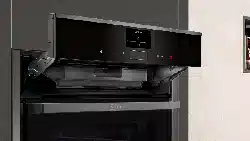Loading ...
Loading ...
Loading ...

How it works en
41
Recommended settings for slow cooking
Food Accessory/cook-
ware
Shelf pos-
ition
Searing
time in
mins
Heating function
→Page7
Temperature
in °C
Cooking
time in
mins
Duck breast, medium
rare, 300g each
Uncovered cook-
ware
2 6 - 8 90
1
45 - 60
Fillet of pork, whole Uncovered cook-
ware
2 4 - 6 80
1
45 - 70
Fillet of beef, 1kg Uncovered cook-
ware
2 4 - 6 80
1
90 - 120
Veal medallions, 4cm
thick
Uncovered cook-
ware
2 4 80
1
30 - 50
Saddle of lamb, bone-
less, 200g each
Uncovered cook-
ware
2 4 80
1
30 - 45
1
Preheat the appliance.
Proving dough
Always allow dough to prove in two steps: Once in their
entirety (1.-dough fermentation) and a second time
when shaped (2.–final fermentation).
Requirement:The cooking compartment is cold.
1.
Dough fermentation:
‒ Slide the wire rack into the cooking compart-
ment.
‒ Place the dough in a bowl onto the wire rack.
‒ Use the recommended settings when configuring
the appliance settings.
‒ Do not open the appliance door while the dough
is proving, otherwise moisture will escape.
2.
Final fermentation:
‒ Continue processing the dough and turn it into
the final shape for baking.
‒ Place the dough in the specified shelf position.
3.
Wipe the cooking compartment dry before baking.
Recommended settings for proving dough
Food Accessory/cookware Shelf posi-
tion
Heating
function
→Page7
Temperature in °C Cooking time
in mins
Rich dough, e.g. panettone Bowl on wire rack
Tin/dish on the wire
rack
1. 2
2. 2
1.
2.
1. 2
2. 2
1. 40–90
2. 30–60
White bread Bowl on wire rack
Universal pan
1. 2
2. 2
1.
2.
1. 1
2. 1
1. 30–40
2. 15–25
Defrosting
You can defrost frozen food in your appliance.
Tips for defrosting food
¡ You can use the appliance to defrost frozen fruit, ve-
getables or baked goods.
¡ It is better to defrost poultry, meat and fish in the re-
frigerator.
¡ Remove frozen food from its packaging before you
defrost it.
¡ The recommended settings are for freezer-temperat-
ure food (-18°C).
¡ When defrosting food, use the following shelf posi-
tions:
– 1 wire rack: Shelf position 2
– 2 wire racks: Shelf positions 3+1
¡ Stir or turn the food 1-2times during defrosting.
Turn large items several times. Split the food into
smaller pieces as it defrosts.
Remove pieces that have already defrosted from the
cooking compartment.
¡ Once the food has defrosted, switch off the appli-
ance and leave the food in the appliance for another
10 to 30minutes to allow the temperature to equal-
ise.
Reheating
You can use steam-assisted reheating to gently warm
up food. The food tastes and looks as though it has
been freshly cooked. You can even warm and crisp up
baked goods from the day before.
Tips for reheating food
¡ Use uncovered, heat-resistant cookware that is suit-
able for cooking with steam.
¡ Use wide, shallow cookware. Reheating takes
longer if you use cold cookware.
¡ Place the cookware on the wire rack.
¡ Place food that you are not reheating in cookware
(e.g. bread rolls) directly onto the wire rack at
level2.
¡ Do not cover the food.
¡ Do not open the cooking compartment door while
the food is being reheated, otherwise large amounts
of steam will escape.
Loading ...
Loading ...
Loading ...
